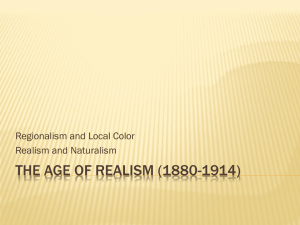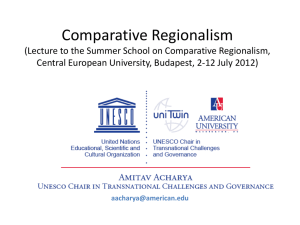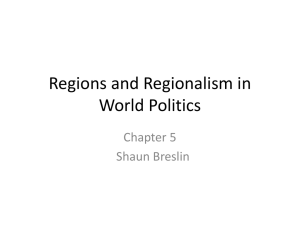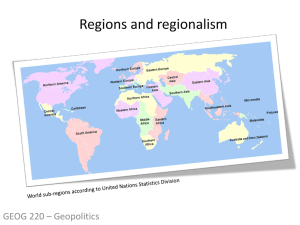Power Preponderance, Institutional Homogeneity and the Likelihood
advertisement
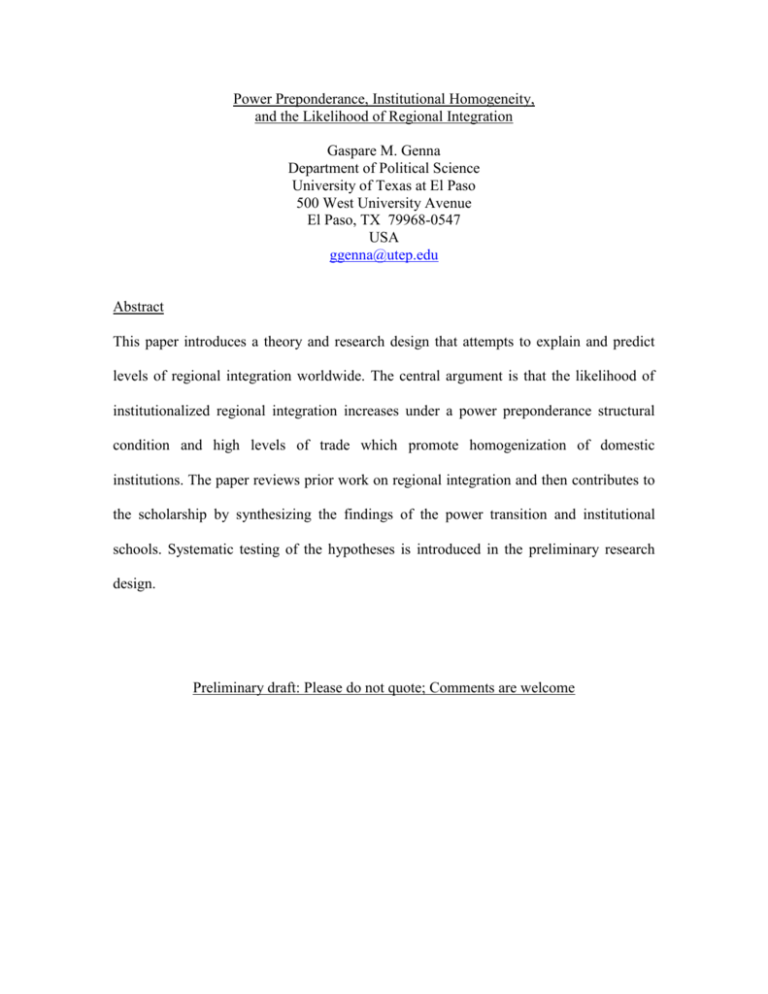
Power Preponderance, Institutional Homogeneity, and the Likelihood of Regional Integration Gaspare M. Genna Department of Political Science University of Texas at El Paso 500 West University Avenue El Paso, TX 79968-0547 USA ggenna@utep.edu Abstract This paper introduces a theory and research design that attempts to explain and predict levels of regional integration worldwide. The central argument is that the likelihood of institutionalized regional integration increases under a power preponderance structural condition and high levels of trade which promote homogenization of domestic institutions. The paper reviews prior work on regional integration and then contributes to the scholarship by synthesizing the findings of the power transition and institutional schools. Systematic testing of the hypotheses is introduced in the preliminary research design. Preliminary draft: Please do not quote; Comments are welcome 2 Introduction What explains the variation of regional integration worldwide? The literature on regional integration is as old as the first attempts to establish the European Union (EU), but the attempt to develop generalized theories with systematic testing is relatively new. As the number of regional projects increases, with the added complexity of overlapping memberships, we are faced with task of explaining and predicting these new movements of cross border cooperation. The project outlined in this paper attempts to continue the current trend of theory development and empirical analysis. After reviewing the range of theories, a central argument will be developed that will synthesize power transition and institutional theories of regional integration. Specifically, the likelihood of institutionalized regional integration increases under a power preponderance structural condition and high levels of trade which promote homogenization of domestic institutions. A common definition of regional integration states that it is a shifting of certain national activities toward a new center (Haas 1958). Integration therefore is a form of collective action among countries in order to obtain a certain goal. This goal can be as grand as political unification (in the case of the EU) or a free trade area, as found in the North American Free Trade Association (NAFTA). Lindberg refines the definition by proposing that it is an “evolution over time of a collective decision making system among nations. If the collective arena becomes the focus of certain kinds of decision making activity, national actors will in that measure be constrained from independent action” (1970: 46). In economic terms it is “a series of voluntary decisions by previously sovereign states to remove barriers to the mutual exchange of goods, services, capital, or 3 persons” (Smith 1993: 4). Also in the vein of economics, integration can also simply mean the degree of market merger among states. This refers to the amount of goods, services, capital, and labor flows among states. While this captures an essence of what is occurring, it misses the institutional aspect of integration which is central to its definition. The degree of market merger occurs because the states have negotiated an established practice of market flows and their regulation. For the purposes of this paper, the definition of integration will follow closely the definitions purposed by Hass and Lindberg. Regional integration1 is the establishment of regular collective decision making among states for the intention of establishing and regulating market flows. The degree of integration refers to the degree of collective decision making. At one end is an intergovernmental arrangement in which states make common decisions but are autonomous in regulating those decisions. If a regional authority does exist, it services at the pleasure of the individual states. On the opposite end is the supranational arrangement, in which regional institutions do exist and make decisions alongside intergovernmental arrangements or supersede the states’ authority. The rest of the paper examines the literature on regional integration with the aim of reviewing, critiquing, and synthesizing prior thoughts. The synthesis is the establishment of a general theory of regionalism. The subsequent sections will examine the method to test the key hypotheses using systematic measures of the variables and future direction of this proposed research. 1 The terms regionalism and regional integration will be used interchangeably in this paper. 4 The Literature on Regional Integration Although the literature on regional integration has an extensive epistemology, general theories of regionalism are still at the early stages of development. In addition, most of the research is Eurocentric. Theories of regional integration can be roughly grouped into three perspectives: (1) neofunctionalism and institutionalism; (2) international power and security theories; and (3) domestic politics and intergovernmentalism. In the first group, neofunctionalism posits that regional integration arises due to increasing technological, economic, and other complexities and problems that countries can no longer effectively solve at the nation-state level (Haas 1958; Mitrany 1975). According to this perspective, governments are likely to enter into cooperative arrangements in order to cope with various functional needs, such as the improvement of economic welfare for their citizens. Once the political elite establish a cooperative arrangement, the theory predicts that integration would become self-perpetuating through a “spillover” process (Haas 1958). Through this mechanism, success in one functional area increases demands for cooperative arrangements in other functional areas due to two reasons. First, demand would increase because successful integration in one area would gain supporters in other areas. Second, further integration in another area or areas would allow integration in the original area to fully succeed. While neofunctionalism was influential in the 1950s and 1960s, it has been criticized as being a post hoc theory having difficulties in generating testable hypotheses because many of the variables in question are not easily operationalized. Neofunctionalism also cannot predict a priori the issueareas in which regional cooperation or integration occurs. In addition, functional needs do 5 not necessarily predetermine the direction of change that states may choose to pursue (see Pentland 1973). Institutionalism, which emerged in the 1980s, inherited the thinking of the neofunctionalist school. Put simply, institutionalists argue that international institutions promote cooperation by helping states overcome collective action problems. By lengthening the shadow of the future and by increasing transparency and enforcement of cooperation, international institutions facilitate issue-linkages and strategies of reciprocity and make international commitments more credible (Axelrod and Keohane 1986; Martin 1992; Simmons 2000). Keohane (1984), for example, claims that it is possible to create and sustain, even after the decline of a hegemonic power, international regimes in order to cope with market failures, reduce transaction costs, and respond to other problems that are difficult to be managed at the national level. With respect to European integration, institutionalists have studied the impact of the European Union institutions on the decision-making process, such as the agenda-setting power of the European Parliament (Tsebelis 1994; Garrett and Tsebelis 1996). Garrett and Weingast (1993) argue that institutions are not simply the facilitators of efficiency gains in the process of regional integration; they also provide focal points—precedents and symbols around which actors’ behaviors converge—that help determine particular choices made at critical decision points. Institutionalism has stimulated important research on international cooperation and integration. However, applying this research to understand non-European regional integration has been limited. This dearth of research may be due to the weak supranational institutional developments outside Europe. Moreover, the degree of 6 institutionalization itself is a variable that needs explication, but institutionalism, except for resorting to the functionalist argument of efficiency gains, has a difficulty explaining the emergence of supranational regional institutions. Furthermore, researchers have criticized institutionalism for its focus on absolute gains, neglecting the possibility of absolute losses (Oatley and Nabors 1998) and relative gains (Grieco 1988). Another take on the institutional argument focuses on state level institutions and how variation in domestic institutions influences the degree of regionalism. Feng and Genna (2003) reexamine the concept of institutions. Instead of looking at the rules and pattern of organized governance, they examined the established set of preferences in key areas of liberalization: (1) money and inflation, (2) government operations and regulations, (3) takings and discriminatory taxation, and (4) international exchange. They find that the homogeneity of institutions among member-states not only facilitates integration, but that integration promotes greater homogeneity among members. This mutually reinforcing mechanism not only explains the level of integration in Latin America, Southeast Asia, and Europe, but also explains the varying pace of integration in each case. Power theories stress the distribution of power among states as a central factor influencing international outcomes. Among power theories, neorealism argues that the asymmetric gains from exchange tend to hinder international cooperation (Waltz 1979; Grieco 1988). However, many neorealists do not completely rule out such possibilities. For example, Gowa and Mansfield (1993), Gowa (1994), and Mansfield and Bronson (1997) argue that commercial liberalization is more likely among states that are political and military allies than among states that are actual or potential adversaries. They propose a defensive realist approach in which commercial liberalization strengthens 7 mutual security among allies: states prefer to have strong allies and trade can aid in strengthening allies’ economies and thereby improving military capabilities. Grieco (1997) advanced a “relative disparity shift” hypothesis where a trend of shifting relative disparity in the capabilities of states within a region is likely to lead disadvantaged states to oppose the development of formal regional institutions while relative stability of capabilities tends to foster the establishment and deepening of such regional arrangements. Grieco’s study comparing relative capability change and the development of regional integration in Western Europe, East Asia, and the Americas largely supports his hypothesis. Hegemonic stability theory likewise emphasizes the importance of power for international political and economic outcomes. The early version of hegemonic stability theory concerned the rise and maintenance of the liberal international economic order (Krasner 1976; Gilpin 1987). Proponents of hegemonic stability theory argued that the presence of a hegemonic state (that is capable of and committed to promoting economic liberalism) was a necessary condition to sustain liberal international commerce. The erosion of hegemony, by contrast, tends to give rise to protectionism. In line with this argument, Gilpin (2001) recently advanced a thesis that the existence of one or more powerful states committed to integration is the key to the successful evolution of regional economic institutions. Like other power-centered theories, power transition theory focuses on the relative power of countries in the international system. Unlike neorealist theorists, however, power transition scholars differ in important areas. First, power transition scholars do not assume an anarchic international system but assume a hierarchic order presided over by 8 the preponderant power (Organski 1958; Organski and Kugler 1977, 1980; Tammen et al. 2000; see Lemke 1996, 2001 for application to local hierarchies). The preponderant power establishes a set of status quo arrangements with the help of willing allies either at the global or regional level or both depending on the size of the preponderant power; the larger the power of the state, the greater its capabilities, the longer the territorial reach. A status quo arrangement is the set of conditions under which all states operate. One important example is the demarcation of territorial boundaries and border permeability. There theory stresses the satisfaction with the status quo relationship between dyads of countries and the dynamics of a power transition that occurs when a subordinate power approaches and exceeds the capabilities of the preponderant power. As applied to international conflict, power transition theory posits that conflict is likely to occur when the subordinate and preponderant powers are at near parity and are dissatisfied with the status quo relationship. In contrast, a peaceful transition occurs if both powers share compatible preferences and are therefore jointly satisfied with the status quo relationship. Efird and Genna (2002) extend the theory and argue that the development of regional integration after a power transition between two satisfied powers improves because the formerly less powerful country has a vital interest in not only maintaining but also furthering and institutionalizing the arrangements that it believes to have contributed to its rise.2 Efird and Genna’s statistical test provides strong support for their hypothesis. Genna and Hiroi (2004; forthcoming) modified the theory by focusing in on the impact of trade dependence in one time period on the degree of integration at a subsequent time period. Explanatory power improved in the cases of Latin American integration by 2 See also Efird, Genna, and Kugler (2003). 9 examining the satisfaction of trade dependence instead satisfaction with the status quo in general. The final group of regional economic integration research stresses the importance of domestic politics and intergovernmental bargaining. By “taking preferences seriously” (Moravcsik 1997), this literature emphasizes the distributional consequences of economic policies for domestic societal groups and the desire of political leaders to hold onto power. At its core, scholars working with this approach contend that governments’ economic policies are strongly influenced by distributional conflict among societal groups; that groups that expect to lose from integration will oppose it and those that anticipate to benefit from it will support it; and that economic policies often reflect the preferences of the more powerful and better organized interest groups in society (Frieden 1991, 1998; Milner 1988, 1997; Rogowski 1989; Moravcsik 1997). Interest group politics, however, is not the whole story. Politicians have their preferences and interests. This literature assumes that a politician’s desire to retain office is the crucial guiding principle of policy making. Moreover, domestic political institutions are argued to shape the patterns of interactions between domestic groups and whose interests will be represented in governments’ policies (Putnam 1988; Garrett and Lange 1995). Similarly, intergovernmentalism posits that economic interests are the driving forces of regional integration. Moravcsik (1998) argues that commercial interests of leading domestic producers, macroeconomic preferences of ruling governmental coalitions, bargaining among powerful national governments over the distributive and institutional issues account for the developments of European integration. Haggard (1997) generally 10 agrees with Moravcsik’s thesis. Haggard (1997) contents that the more powerful states largely shaped the bargaining agendas in economic integration in Asia and the Western Hemisphere. However, the interests of weaker states also affect—although to a lesser degree—the regional economic agreements. What is crucial for economic integration to proceed, in Haggard’s view, is the convergence of preferences among parties to regional agreements that facilitate the bargaining and construction of regional economic blocs. He claims that the differences between the developments of East Asian and Latin American regional integration are due to the differences in the convergence or divergence of preferences of member countries about the direction and extent of economic integration. A General Theory of Regionalism The literature in total provides several important variables in developing a general theory of regionalism. First, the distribution of capabilities in regional systems matter. The empirical evidence shows that asymmetric distribution of power is a more favorable condition for this interdependence to develop. This is due to the ability of the preponderant power to coordinate efforts and distribute incentives to other members. Second, states do have a favorable interest to become economic interdependent. The central assumptions of neorealism lead us to believe that states prefer low to no levels of interdependence because their level of security diminishes. However, defensive realists agree that interdependence will occur among allies due to their need for mutual security. Hegemonic stability and power transition theories also agree that states do see these benefits. Third, preferences are highly important. Being satisfied with prevailing conditions influences states to protect the status quo. By institutionalizing the status quo, 11 states improve the certainty of a favorable future. Fourth, the link between regional level and domestic level politics helps explain the production of preferences. Preferences develop as a result of an aggregation of domestic desires. These desires spawn from competing groups that interact in the domestic arena, with the preferences of the more power groups being more likely to be expressed. Fifth, the homogeneity of institutional preferences lowers the costs of cooperation because states follow similar polices. States that wish to free ride on other states’ policies are not likely to be present thereby improving the certainty that distribution of benefits will be based on negotiated market interactions and not harmful unilateral state action. Sixth, the relationship between homogeneity and integration is reinforcing. As already stated, homogeneity of institutions increases the likelihood of regionalism. But the effect of increased regionalism also increases the likelihood of further homogeneity. Finally, a synthesis of the prior findings suggests that another feedback mechanism is present. As integration and homogeneity increases, then the level of satisfaction is likely to improve. This assumes that regionalism produces the benefits hypothesized by liberal economics (Krugman and Obstfeld 2002). Figure one maps out the causal pathways of regionalism given the reviewed research. The structural conditions for regionalism include the presence of a regional preponderant power and a satisfaction with trade dependence among potential or existing memberstates. The two variables interact since together they are a necessary and sufficient condition for integration. This set of conditions promotes greater institutional homogeneity. The preponderant power can lead in promoting similarities among institutionalized policies such as inflation targets, government regulations, taxation, and 12 international exchange. Satisfaction among the relatively smaller powers gives the preferences of the preponderant power credence. The increased homogeneity increases the likelihood of creating or deepening integration. With homogeneity uncertainty and costs of integration are lowered, leading states to cooperate. Integration furthers the likelihood that homogeneity among the member-states will increase and thereby leading to further integration. As the reinforcement of homogeneity and integration continues this will feedback to the level of satisfaction with interdependence. If integration is successful in providing aggregate benefits, then satisfaction with interdependence will improve. This in turn interacts with the asymmetric power conditions and thereby further strengthens the homogeneity-integration cycle. The likelihood that pathways will breakdown or slowdown increases during the relatively brief period of power transition. Since integration will spawn high levels of status quo satisfaction, integration will promote peaceful power transitions. Figure one: Causal Pathways of Regionalism Preponderance*Status Quo Satisfaction Homogeneity Integration The entire pathway cannot be tested as a whole. Instead it can be deconstructed into various linear pathways: (Preponderance*SQ Satisfaction) → Homogeneity → Integration (Preponderance*SQ Satisfaction) → Integration → Homogeneity 13 Homogeneity → Integration → SQ Satisfaction Integration → Homogeneity → SQ Satisfaction These pathways can be tested using the following regression equations: Integrationt+b= 1 + 1Institutiont+a+ 1(Preponderance*SQ Satisfaction)t+ t+b Institutiont+c= 2 + 2Integrationt+b+ 2(Preponderance*SQ Satisfaction)t+ t+c SQ Satisfactiont+d= 3 + 3Integrationt+b+ 3Institutiont+a + t+d SQ Satisfactiont+d= 4 + 4Integrationt+b+ 4Institutiont+c + t+d Where a < b < c < d. Hypothesis Testing Hypothesis testing will require an econometric method that will consider the structural and time dependency characteristics of the hypotheses. More thought and research regarding the testing method will be necessary. However, the operationalization of the variables is partially completed. The unit of analysis is the individual cases of regionalism. This may produce a biased result since only cases of regional integration that do exist will be included. However, this bias can be corrected by also included cases that are still being negotiated but have not yet been established. Therefore the data set will include values of the dependent that vary including some with the value of zero (no integration). The operationalization of regionalism must include systematic coding so that the analysis can distinguish varying levels while still comparing similar attributes. This is done by using a multidimensional measurement referred to as the integration achievement score (IAS), which was first developed by Hufbauer and Schott (1994). The 14 calculation of the IAS in their work involves a smaller number of regional integration organizations for a single year, 1994. The updated score adds greater precision to their method, includes a greater number of regional integration projects, and involves an expanded timeframe. Table one describes the coding system employed to generate the IAS. It gauges the level of regional integration by looking at six categories commonly attributable to regionalism: (1) trade in goods and services, (2) degree of capital mobility, (3) degree of labor mobility, (4) level of supranational institution importance, (5) degree of monetary policy coordination, and (6) degree of fiscal policy coordination. The coding system also breaks down the six categories into five levels along a Guttman scale. The final measure is an average of the six categories, allowing for an equal weight for each. The data used to estimate the IAS comes primarily from the Europa World Year Book and cross-referenced with other specialized sources. The appendix includes an example of the coding method as applied to estimating the level of integration among members of the EU. Of the various macro-geographic regions, the level of integration in Africa is the lowest. Levels of Asian and North and South American integration are higher than those in Africa, with the highest levels found in Europe. Currently, the score is being updated to include all cases of regional integration registered with the World Trade Organization from inception to 2003. Power preponderance is relatively simple to operationalize. The formula is a ratio of the preponderant’s power to that of all the other states: PP GDPi j GDP j 1 j 15 j Where GDPi is the gross domestic product of the preponderant power and GDP j 1 j is the sum of the gross domestic product of the first to the jth member of the region. The data on GDP come from the Global Development Network Growth Database. Satisfaction with the status quo is determined by the total value of exports within the trading block as a ratio of total intra-regional output: SQSatisfaction Exports GDP Exports are used instead of total trade (imports plus exports) to prevent double counting. Also, it is less likely for states to misrepresent their export values relative to import values. A ratio of total output is needed so as to determine the level of trade dependence among the member-states. The trade values come from International Monetary Fund direction of trade statistics. Homogenization is determined by the standard deviation of the economic institutional variables (Gwartney and Lawson 1997). A large standard deviation implies substantial difference among member states in their economic institutions and therefore a lack of homogeneity in the area of economic policies. The economic institutional indices have seventeen components in four major areas: (1) money and inflation, (2) government operations and regulations, (3) taxation, and (4) international exchange. These four areas represent the major dimensions of a country’s economic institutions, and the ratings are ranked to indicate levels of economic freedom (see table two). Conclusions: Next Steps in the Research Project The work thus far has introduced a general theory of regionalism and now requires further data tabulation and hypothesis testing. The theory is a synthesis of established 16 work and hopes to contribute to the research agenda on regionalism by providing a fuller and generalizable set of explanations for integration’s creation and development. The general theory proposes a causal pathway where power preponderance and mutual trade dependence leads states to homogenize institutional policies. The homogenization process promotes formal integration with the reciprocal effect of promoting further homogenization. The reinforcing mechanism then feedbacks and increases the level of mutual trade dependence. The major theoretical implication is that a peaceful transition of power is likely to occur during a structural redistribution within the regional system. The next step is to test the hypotheses using data already collected. However more cases will be added to the IAS and its time line will be extended to 2003. In addition the appropriate method of econometric testing has yet to be finalized. The method will need to be able to model the structural equation and time dependence characteristics of the hypotheses. Since the observations will include all examples of regional integration, the estimated parameters are population parameters and not sample estimations. Finally, the resulting parameters can be used to forecast the development of relevant cases of regionalism, such as East Asian integration, given the theoretical assumptions and estimated values of the independent variables. Policy recommendations can be then made from these forecasts. 17 Table one: Integration Achievement Score (coding system) 1. Trade in Goods and Services 0 = No agreements made to lower tariffs and non-tariff barriers 1 = Preferential Trade Agreement 2 = Partial Free Trade Area 3 = Full Free Trade Area 4 = Customs Union 5 = No barriers among member countries 2. Degree of Capital Mobility 0 = No agreements made to promote capital mobility 1 = Foreign Direct Investment allowed in limited form 2 = Capital withdrawal allowed 3 = Full access for foreign investment and capital withdrawal, except for national government procurement 4 = Full capital mobility expect for large scale merges and acquisitions 5 = Full capital mobility without restriction 3. Degree of Labor Mobility 0 = No agreements made to promote labor mobility 1 = Right of movement granted for select professions 2 = Full right of movement 3 = Transferability of professional qualifications granted 4 = Transferability of pensions and other retirement devices 5 = Full freedom of movement 4. Level of Supranational Institution Importance 0 = No supranational institutions 1 = Establishment of nominal institutions 2 = Information gathering and advisory role 3 = Ability for institutions to amend proposals 4 = Ability for institutions to veto proposals 5 = Supranational institutions operate as primary decision node 5. Degree of Monetary Policy Coordination 0 = No monetary policy coordination 1 = Consultation regarding policy 2 = Commitment to maintain parity 3 = Coordinated interventions 4 = Regional Central Bank establishment 5 = Single currency 6. Degree of Fiscal Policy Coordination 0 = No fiscal policy coordination 1 = Consultation regarding policy 2 = Commitments regarding deficit spending and taxation 3 = Sanctions regarding breaking commitments 4 = Uniform tax code 5 = Single budget 18 Table two: Economic institutions and freedom 1. Money and Inflation (Protection of money as a store of value and medium of exchange) A. Average annual growth rate of the money supply during the last five years minus the potential growth rate of real GDP. B. Standard deviation of the annual inflation rate during the last five years. C. Freedom of citizens to own a foreign currency bank account domestically. D. Freedom of citizens to maintain a bank account abroad. 2. Government Operations and Regulations (Freedom to decide what is produced and consumed) A. Government general consumption expenditures as a percent of GDP. B. The role and presence of government-operated enterprises. C. Price controls—the extent that businesses are free to set their own prices. D. Freedom of private businesses and cooperatives to compete in markets. E. Equality of citizens under the law and access of citizens to a nondiscriminatory judiciary. F. Freedom from government regulations and policies that cause negative real interest rates. 3. Takings and Discriminatory Taxations (Freedom to keep what you earn) A. Transfers and subsidies as a percent of GDP. B. Top marginal tax rate. C. The use of conscripts to obtain military personnel. 4. Restraints on International Exchange (Freedom of exchange with foreigners) A. Taxes on international trade as a percent of exports plus imports. B. Difference between the official exchange rate and the black market rate. C. Actual size of trade sector compared to the expected size. D. Restrictions on the freedom of citizens to engage in capital transactions with foreigners. 19 Appendix: an example of the IAS coding method using the case of the European Union Trade, in goods and services, is the first category. Higher levels of liberalization of barriers to the trade of goods and services among the member states receive higher values in this category. In the case of the EU, at its inception as the European Coal and Steel Community (ECSC), it receives a value of 2. After the signing of the Treaty of Rome it receives a value of 3 because trade liberalization had expanded into a customs union with its full realization in 1968 (Wood and Yesilada 1996) moving the value to 4. The value remains at 4 up to 1996. The 1970’s and early 1980’s marks the period of “Europessimism” in which movement towards higher levels of integration stagnated. Therefore since 1968 there has not been much variation in this category for the EU. The second category is free movement of capital. Liberalization in this category refers to direct investment in partner counties with the associated ability to withdraw investment. This category closely parallels the free trade and services category for the EU. In 1952 through the signing of the Treaty of Rome, the EU receives a value of 2 because the capital mobility was restricted to a limited amount of enterprises. After 1958, the score increases to 3 after the establishment of the customs union. This allowed for greater liberalization in capital mobility but national government procurement was not open to firms of partner countries (Cecchini 1988). After 1992 the value of this category increases to 4 for the EU because the Single European Act (SEA) allows for complete freedom of capital movement (Molle 1997). It does not achieve a 5, however, because member countries still favor takeovers of existing firms from home nationals (Hufbauer and Schott 1994). 20 Following liberalization of capital is labor mobility. The ability of labor to seek higher wages or other employment opportunities in the partner countries signifies that a single labor market is present. This single labor market is a strong indicator of an integrated economy because another factor of production can be efficiently distributed. As the ECSC, the EU did not have much in the way of allowing workers access to labor markets. After 1957, the value increases to 2 because real barriers to labor mobility were not removed until the SEA allowed for free movement of individuals without passport restrictions within the European Community (McKay 1996). After 1992 the value increases to no more than 3 because the transfer of professional qualifications are limited as are the transferability of pension rights (Hufbauer and Schott 1994). The next category is that of supranational institutions. Supranational institutions take over the decision making in various areas from the nation-state. In order to score the maximum value in this category (that of 5), the supranational institutions need not command all authority within the integrating region. For example in the case of the United States, a fully integrated region, federalism does not dictate that all power rests in Washington, D. C. The individual states hold power and sovereignty in many areas. For the EU, the value of 2 describes it from the time of the ECSC through the Treaty of Rome. Under the ECSC, the creation of the High Authority transferred the authority of decision making for production of coal and steel to the nine-member panel, however their decisions were subject to approval by the Council of Ministers (McKay 1996). From 1957, new institutions were created that are present today: the Commission, Parliament, and Court of Justice, increasing the value to 3. The value increases to 4 after 1974 due to demise of the Guallists in France and a resulting increase of real authority of the 21 Commission (Wood and Yesilada 1996). The value increases to 5 after the adoption of the SEA (Hufbauer and Schott 1994). The last two categories involve the monetary and fiscal categories of regional integration. The category of monetary coordination refers to the progress in the establishment of common policies that adjust exchange rates among the member countries. The value of this category is zero up through the adoption of the Treaty of Rome when the value increases to 1. Under the Treaty of Rome monetary coordination was set on the agenda but did not receive full attention until 1972 with the establishment of the “Snake,” increasing the value of monetary coordination to 2. The Snake did not fair well due to the economic conditions of the times requiring various member countries to pull out in order to shore up the home economies (Molle 1997). In 1979 the first real steps toward monetary union came about with the European Monetary System (EMS). The value increases to 3 under the EMS because it established the European Currency Unit (ECU) and the Exchange Rate Mechanism, which required a pledge to maintain set ends in 1996, the more recent developments of the Euro are not included. The final category is fiscal coordination. This refers to the establishment of spending criteria for the member countries. The EU scores a zero for most of its development under this category. It was not until the Treaty of European Union that public deficits were required to be maintained under 3% of GNP and that public debt-to-GNP ratios were set at under 60% (Hufbauer and Schott 1994). At this juncture the EU receives a value of 1. 22 Works Cited Axelrod, Robert and Robert O. Keohane. 1986. “Achieving Cooperation under Anarchy,” in Kenneth Oye (ed), Cooperation under Anarchy. Princeton: Princeton University Press. Cecchini, Paolo. 1988. The European Challenge: 1992, the Benefits of a Single Market. Aldershot, UK: Gower. Efird, Brian and Gaspare M. Genna. 2002. Structural Conditions and the Propensity for Regional Integration. European Union Politics, 3(3): 267-295. Efird, Brian, Gaspare M. Genna, and Jacek Kugler. 2003. From War to Integration: Generalizing the Dynamic of Power Transition Theory. International Interactions, 29(4): 293-313. Feng, Yi and Gaspare M. Genna. 2003. Regional Integration and Domestic Institutional Homogeneity: A Comparative Analysis of Regional Integration in the Americas, Pacific Asia, and Western Europe. Review of International Political Economy, 10(2): 278-309. Frieden, Jeffry A. 1991. Debt, Development, and Democracy: Modern Political Economy and Latin America, 1965-1985. Princeton: Princeton University Press. ______. 1998. “Who Wins? Who Loses?” Foreign Policy. September 1998: 25. Garrett, Geoffrey and Peter Lange. 1995. “Internationalization, Institutions and Political Change.” International Organization 38: 627-655. Garrett, Geoffrey and George Tsebelis. 1996. “An Institutional Critique of Intergovernmentalism.” International Organization 50: 269-299. 23 Garrett, Geoffrey and Barry R. Weingast. 1993. “Ideas, Interests, and Institutions: Constructing the European Community’s Internal Market,” in Judith Goldstein and Robert O. Keohane (eds), Ideas and Foreign Policy. Cornell: Cornell University Press. Genna, Gaspare M. and Taeko Hiroi. 2004. Power Preponderance and Domestic Politics: Explaining Regional Economic Integration in Latin America and the Caribbean, 1960-1997. International Interactions, 30(2): 143-164. _____. forthcoming. Brazilian Regional Power in the Development of Mercosul. Latin American Prospectives. _____. forthcoming. The Effects of Unequal Size: Costs and Benefits of Unilateral Action in the Development of Mercosur. Journal of Developing Societies. Gilpin, Robert. 1987. The Political Economy of International Relations. Princeton: Princeton University Press. ______. 2001. Global Political Economy: Understanding the International Economic Order. Princeton: Princeton University Press. Gowa, Joanne. 1994. Allies, Adversaries, and International Trade. Princeton: Princeton University Press. _____ and Edward D. Mansfield. 1993. “Power Politics and International Trade.” American Political Science Review. 87: 408. Grieco, Joseph M. 1988. “Anarchy and the Limits of Cooperation: A Realist Critique of the Newest Liberal Institutionalism.” International Organization. 42. _____. 1997. “Systematic Sources of Variation in Regional Institutionalization in Western Europe, East Asia, and the Americas,” in Edward D. Mansfield and Helen V. 24 Milner (eds) The Political Economy of Regionalism. New York: Columbia University Press. Gwartney, J. and R. Lawson. 1997. Economic Freedom of the World 1997: Annual Report. Vancouver, B.C.: The Fraser Institute. Haas, Ernst B. 1958. The Uniting of Europe. Stanford: Stanford University Press. Haggard, Stephan 1997. “Regionalism in Asia and the Americas,” in Edward D. Mansfield and Helen V. Milner (eds) The Political Economy of Regionalism. New York: Columbia University Press. Hufbauer, Gary C. and Jeffery J. Schott. 1994. Western Hemisphere Economic Integration. Washington, DC: Institute for International Economics. Krasner, Stephan. 1976. “State Power and the structure of International Trade.” World Politics. 28: 317. Keohane, Robert. 1984. After Hegemony: Cooperation and Discord in the World Political Economy. Princeton, NJ: Princeton University Press. Krugman, Paul R. and Maurice Obstfeld. 2002. International Economics: Theory and Policy, 6th edition. Boston: Addison Wesley. Lemke, Douglas. 1996. “Small States and War,” in Jacek Kulger and Douglas Lemke(eds), Parity and War. Ann Arbor, MI: University of Michigan Press. _____. 2001. Regions of War and Peace. Cambridge, UK: Cambridge University Press. Lindberg, Leon N. 1970. “Political Integration as a Multidimensional Phenomenon Requiring Multivariate Measurement,” in Regional Integration: Theory and Research. Cambridge, MA: Harvard University Press. 25 Mansfield, Edward D., and Rachel Bronson. 1997. “The Political Economy of MajorPower Trade Flows,” in Edward D. Mansfield and Helen V. Milner (eds), The Political Economy of Regionalism. New York: Columbia University Press. Martin, Lisa L. 1992. Coercive Cooperation: Explaining Multilateral Economic Sanctions. Princeton: Princeton University Press. McKay, David. 1996. Rush to Union: Understanding the European Federal Bargain. Oxford: Clarendon Press. Milner, Helen. 1988. Resisting Protectionism. Princeton: Princeton University Press. _____. 1997. “Industries, Governments, and the Creation of Regional Trade Blocs,” in Helen Milner and Edward Mansfield (eds) The Political Economy of Regionalism. New York: Columbia University Press. Mitrany, David. 1975. The Functional Theory of Politics. London: Martin Robertson. Molle, Willem. 1990. The Economics of European Integration. Aldershot, UK: Dartmouth. Moravcsik, Andrew. 1997. “Taking Preferences Seriously: A Liberal Theory of International Politics.” International Organization. 51(5): 513-553. _____. 1998. The Choice for Europe: Social Purpose and State Power from Messina to Maastricht. Ithaca, NY: Cornell University Press. Oatley, Thoman, and Robert Nabors. 1998. “Redistributive Cooperation: Market Failure, Wealth Transfers, and the Basle Accord.” International Organization. 52(1): 35-54. Organski, A.F.K. 1958. World Politics, 1st edition. New York: Alfred A. Knopf. Organski, A.F.K., and Jacek Kugler. 1977. “The Costs of Major Wars: The Phoenix Factor.” American Political Science Review. 71: 1347. 26 _____. 1980. The War Ledger. Chicago: University of Chicago Press. Pentland, Charles. 1973. International Theory and European Integration. London: Faber and Faber. Putnam, Robert. 1988. “Diplomacy and Domestic Politics: The Logic of Two-level Games.” International Organization 42: 427-460. Rogowski, Ronald. 1989. Commerce and Coalitions. Princeton: Princeton University Press. Simmons, Beth A. 2000. “International Law and State Behavior: Commitment and Compliance in International Monetary Affairs.” American Political Science Review. 94: 819-835. Smith, Peter H. (ed). 1993. The Challenge of Integration: Europe and the Americas. London: Transaction Publishers. Tammen et al. 2000. Power Transitions: Strategies for the 21st Century. New York: Chatham House Publishers. Tsebelis, George. 1994. “The Power of the European Parliament as a Conditional Agenda Setter.” American Political Science Review. 88: 128-142. Waltz, Kenneth N. 1979. Theory of International Politics. New York: McGraw-Hill Publishing Company. Wood, David M. and Birol A. Yesilada. 1996. The Emerging European Union. White Plains, NY: Longman Publishers USA.


